Visiting the Kiyotsu Gorge Tunnel should be at the top of your list if your travels are bringing you to Niigata Prefecture, Japan.
The Kiyotsu Gorge, also known as Kiyotsukyo in Japanese, is considered one of the ‘Three Great Gorges of Japan’ together with Kurobe and Osugidani. But what makes this attraction interesting is that it combines stunning natural scenery with an interplay between architecture, art and light.
I first learned about the Kiyotsu Gorge when I came across a photo of someone standing at the edge of the tunnel with their silhouette and the greenery of the rocky gorge reflected in a shallow pool of water.
It looked like something out of this world! Was it real? Was it AI? Could it be an art museum? Where in Japan was this place located exactly and how easy would it be to get there?
I saved the spot to my GoogleMaps with a little pin for a future trip should I ever be in the area. Well, fast-forward a few months and I was actually planning a trip to Japan together with my husband.
When I saw that our travels would be bringing us to Niigata Prefecture, I made sure we detoured to this very spot!
In this blog post, I’ll tell you exactly how to get to the Kiyotsu Gorge Tunnel and what you can expect once you arrive.
Kiyotsu Gorge Tunnel Travel Guide: What to See, Do & Experience on Your Trip
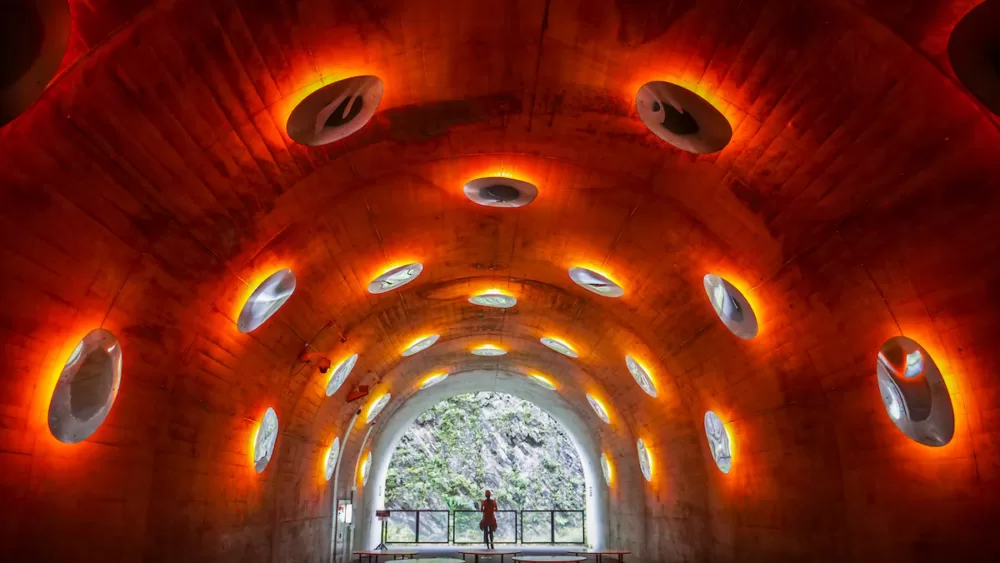
Getting to Kiyotsu Gorge Tunnel
By train and bus
Take the Joetsu Shinkansen to Echigo Yuzawa Station. Once you exit, you’ll walk out to the bus terminal located directly in front of the train station.
You’ll want to take the bus bound for Morinomiyahara Station departing from Platform 4. Confirm with the driver that the bus you’re boarding does in fact go to Kiyotsu Gorge as there are other buses departing from the same platform.
It is a 30-minute bus ride and you’ll get off at Kiyotsukyo Iriguchi (Kiyotsu Gorge Entrance). From there, it is a 20-minute walk to the Kiyotsu Gorge Tunnel.
Tip: Because this bus is a bit infrequent, you’ll want to check the schedule ahead of time and make sure you’re arriving at Yuzawa Echigo Station with enough time to catch the bus. Alternatively, if you miss the bus, you can take a taxi to Kiyotsu Gorge.
By car
If you have a car, you can reach the Kiyotsu Gorge by exiting the Kan-Etsu Expressway at Shiozawa-Ishiuchi and taking Route 353 for about 20 minutes.
There is free parking available on site with overflow lots should it be peak time.
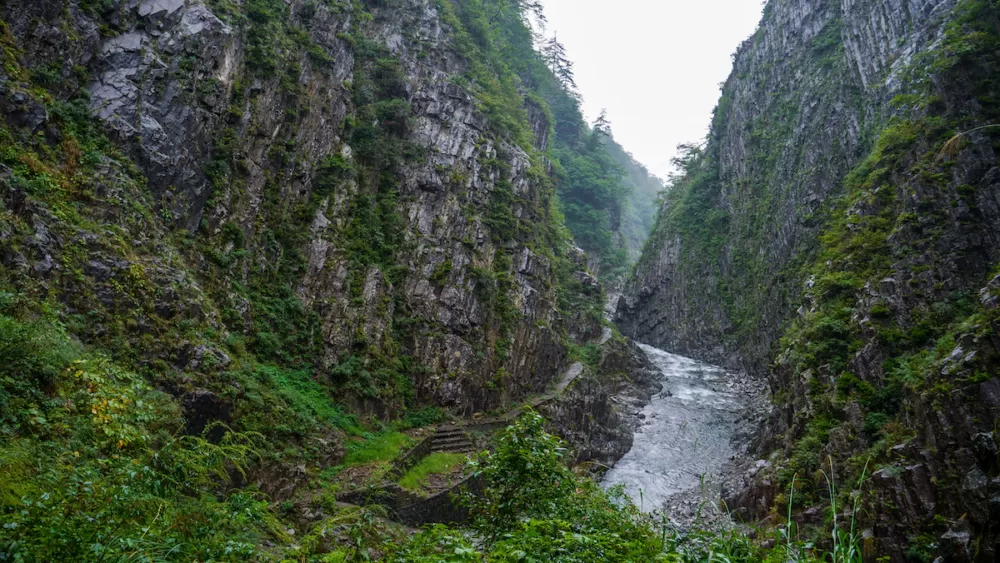
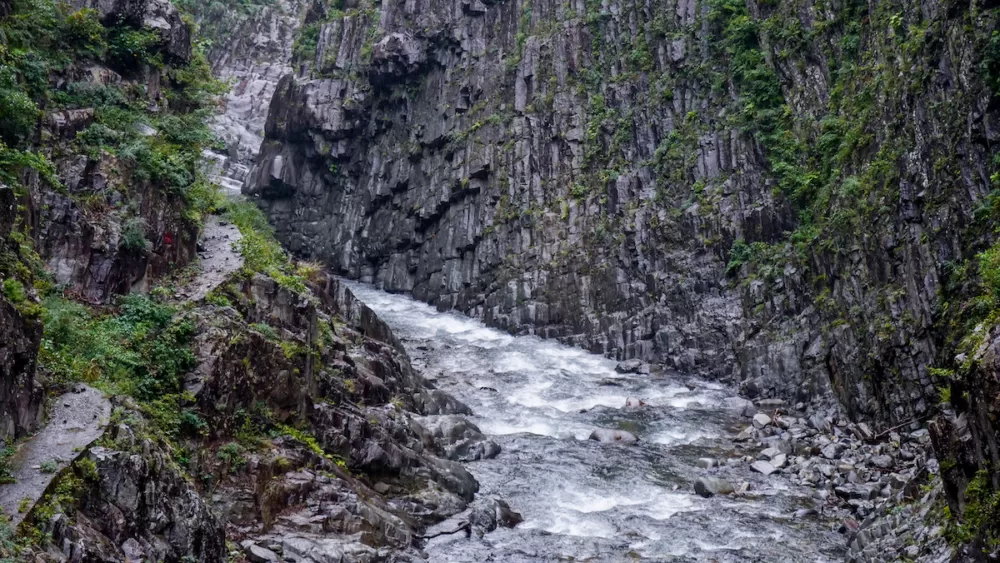
About Kiyotsu Gorge Tunnel
Kiyotsu Gorge is famous for its crystal-clear waters, steep cliffs, and unique rock formations. The gorge stretches approximately 12.5 kilometres and is a product of volcanic activity in the region. The sheer rock walls and the varying shades of green from the surrounding forest create a breathtaking view.
Kiyotsu Gorge was designated a Natural Monument in April 1941 and was made a part of Jōshin’etsukōgen National Park in September 1949.
A highlight of Kiyotsu Gorge is the Tunnel of Light, a 750-meter-long tunnel that was renovated and transformed into an art installation for the Echigo Tsumari Art Triennale in 2018.
This tunnel has several artistic spaces, each offering a different perspective of the gorge and a unique sensory experience. There are mirrored walls, viewing platforms, and soundscapes to enjoy as you make your way down the tunnel. These installations are designed to enhance the natural beauty of the gorge and create a dialogue between art and nature.
Kiyotsu Gorge can be visited as a day trip from Yuzawa, and you have a few days in town, here are some ideas of things to do in Yuzawa.
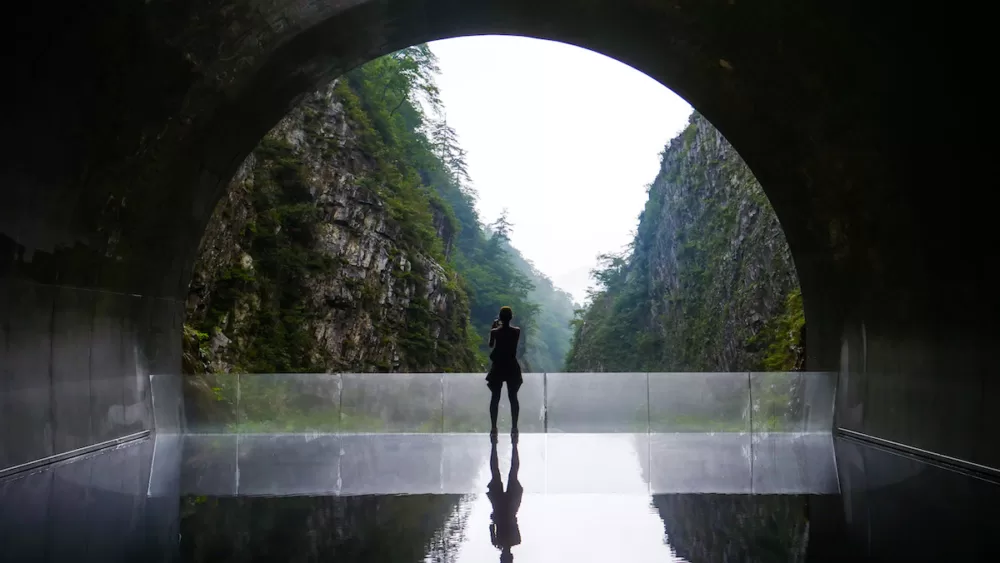
MAD Architects & Kiyotsu Gorge Tunnel
MAD Architects are the ones responsible for the transformation of the Kiyotsu Gorge Tunnel. This architecture firm is known for its innovative and futuristic designs, and in 2018 they renovated and completely transformed the 750-metre tunnel, now known as the Tunnel of Light, creating different art installations.
Here’s a brief explanation of each of the artworks you’ll encounter:
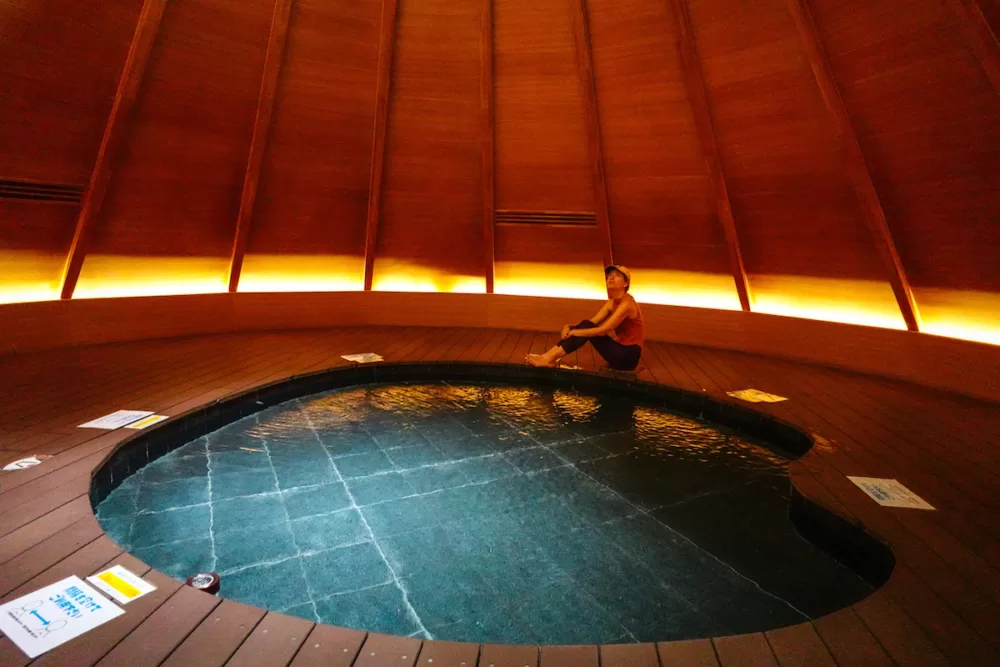
Periscope
The first structure you’ll encounter just before entering the Kiyotsu Gorge Tunnel is Periscope. This is a small structure close to the entrance of the tunnel that features a shop on the ground floor. However, the real attraction is upstairs where you’ll find a foot onsen to dip your feet.
Periscope’s ceiling has a cone shape with a small mirrored opening at the top which reflects the lush landscapes of the Kiyotsu Gorge.
I would recommend visiting Periscope at the end of your visit since it’s a nice way to relax and give your legs a break after walking the length of the tunnel there and back.
The shop on the first floor also sells some nice treats; we opted for chocolate walnut cookies, but they had a wide range of traditional Japanese desserts to choose from.
There are also bathroom facilities on the ground floor should you need them.
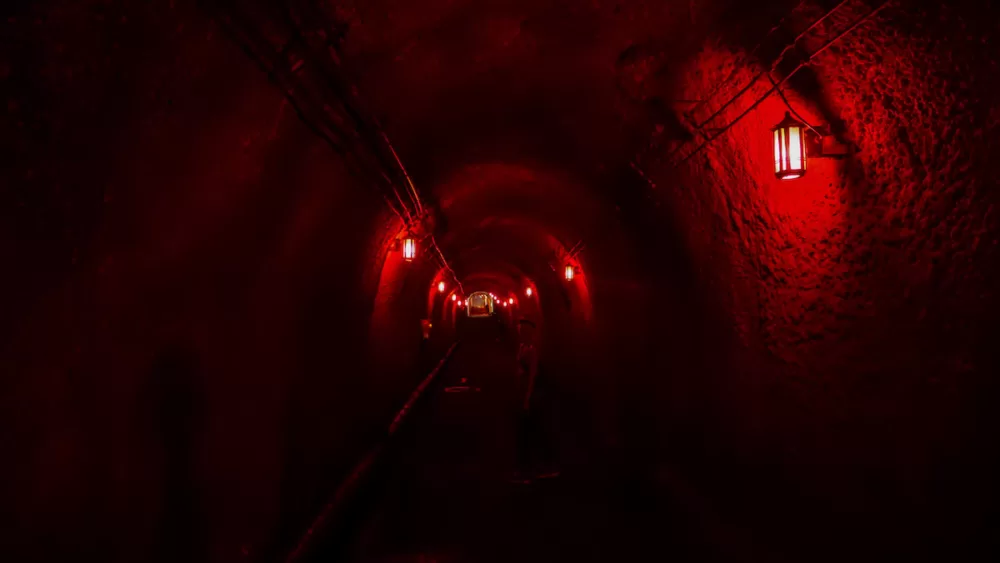
Expression of Color
Once you enter the Kiyotsu Gorge Tunnel, you’ll reach the ticketing booth which is a few meters in on the right-hand side of the tunnel. After paying the cost of admission (¥1000 at the time of our visit), you begin the walk down the 750-metre-long tunnel.
This section of the tunnel is known as the Passageway and the exhibition is called Expression of Colour. This part consists of five different coloured lights paired with some rather ominous chanting music, which leads visitors deeper into the tunnel. The lights go from green to blue to pink to yellow to red.
It’s a little spooky when you’re one of the first people in there walking down a virtually empty tunnel, but it’s all part of the art experience.
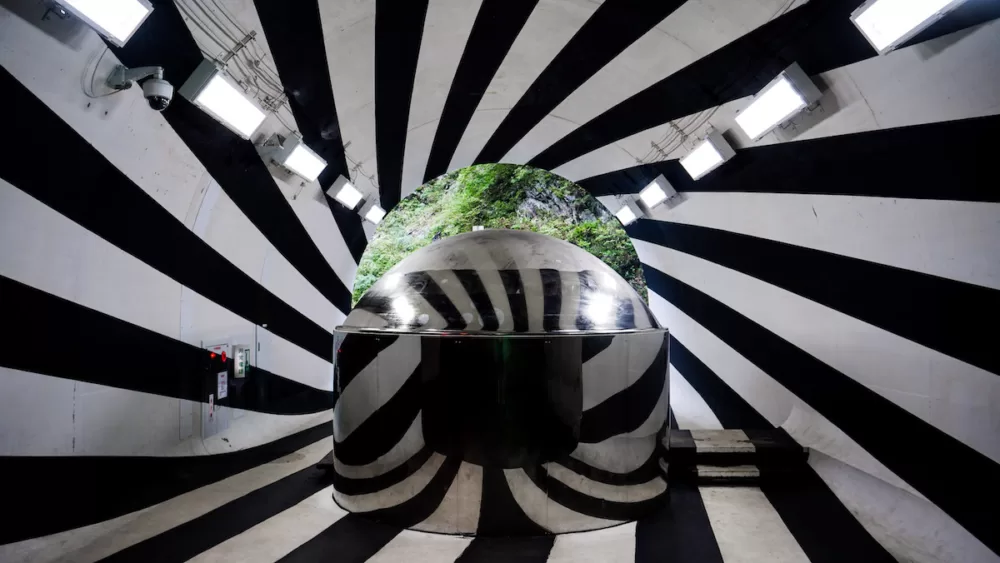
FLOW
Next up, is FLOW which is located on the second viewing platform and is one of the newest additions to the Kiyotsu Gorge Tunnel.
The walls and floors in this space have been painted black and white in a striped swirling effect.
At the centre of this platform is another art installation known as the Invisible Bubble, which serves a rather functional purpose.
Invisible Bubble
The Invisible Bubble of the second platform is actually a toilet! That’s right, this is the only bathroom facility within the Kiyotsu Gorge Tunnel and it’s a work of art in and of itself.
The Invisible Bubble consists of a mirrored dome coated in a metallic film; that means you can see out from the toilet, but nobody can see in.
Because the exterior of this capsule toilet reflects the swirling black and white stripes of the tunnel, it turns into an interesting optical illusion for visitors inside the tunnel.
All this to say, it’s worth a visit even if you don’t need the toilet!
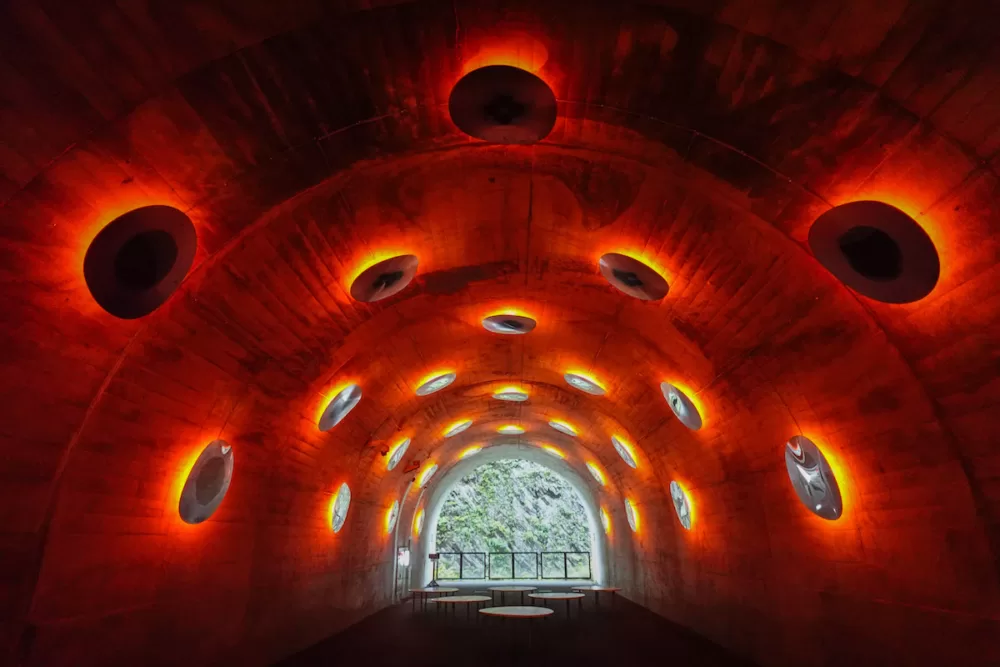
Drops
In the third platform of the Kiyotsu Gorge Tunnel, you’ll find the art installation known as Drops.
As you enter the tunnel, you are met with droplet-like mirrors on the tunnel ceilings and walls lit up by a soft orange neon glow. These mirrors reflect back the rock formations and verdant landscape of the Kiyotsu Gorge and they also reflect the tunnel visitors though in a somewhat distorted form.
The best time to visit this specific platform is at sunset when each of these mirrors is lit by a fiery red light that gives the tunnel a warm feeling. However, we visited in the morning and still enjoyed the tunnel with its orangey glow.
This was my personal favourite art installation in the tunnel because of the interplay between light and nature reflecting in the mirrors, but the next and final attraction is quite an epic one as well.
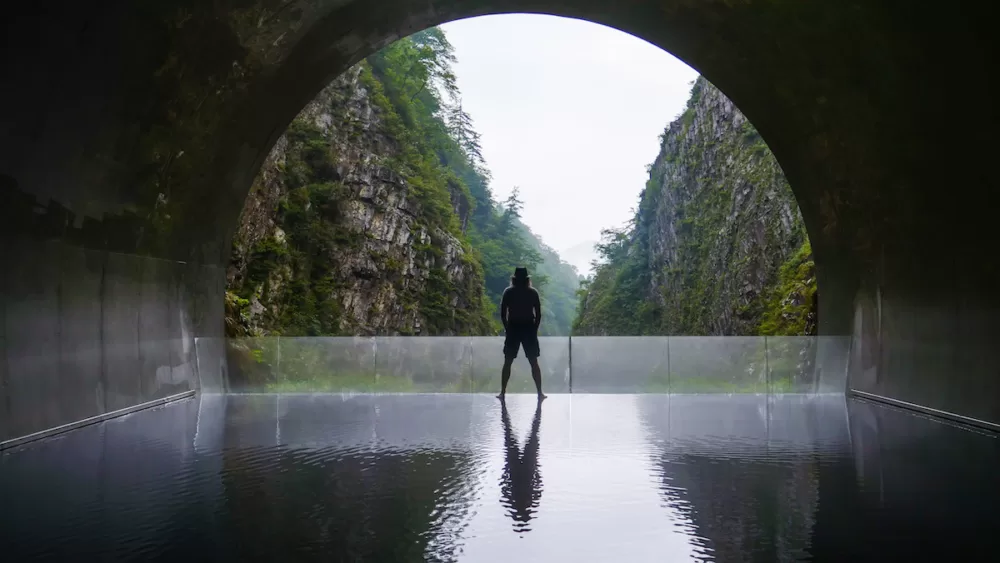
Light Cave
Last but not least, at the end of the Kiyotsu Gorge Tunnel, you’ll reach the Panorama Station which features the iconic Light Cave.
This cave is also known as the Tunnel of Light and it features a tunnel lined with semi-polished stainless steel. On the floor, there’s a very shallow pool with a thin layer of water that acts as a mirror and reflects the green landscape of the gorge.
You can enter the pool barefoot or with shoes on (there are no signs saying so inside the tunnel, but there is a sign confirming so just before you enter the tunnel) and it makes for a very cool photo opportunity as your silhouette reflects in the pool.
The Kiyotsu Gorge Tunnel is one of the coolest places we visited in Niigata Prefecture, so definitely add it to your list if you’re going to be travelling in this corner of Japan!
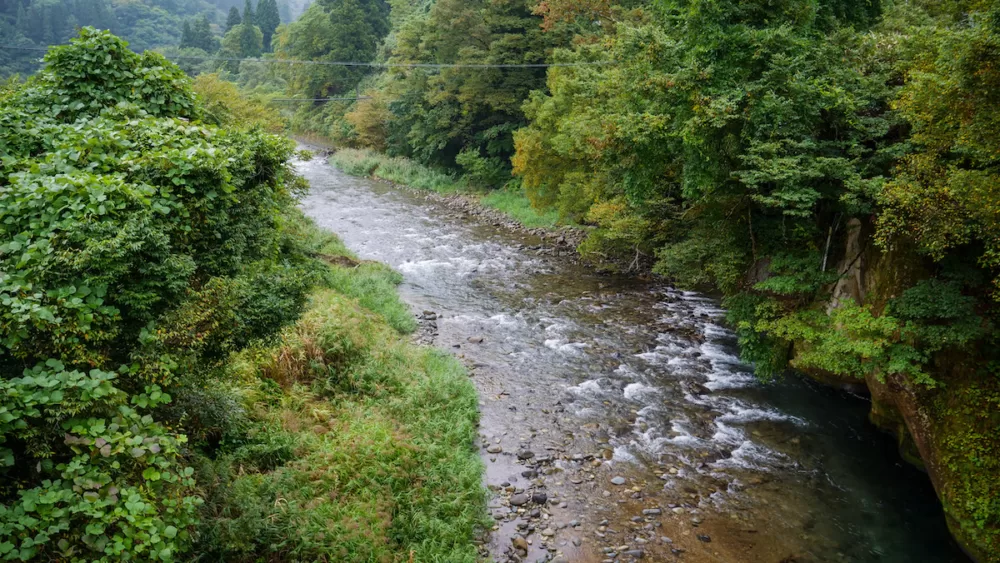
Echigo-Tsumari Art Field
If you enjoy visiting Kiyotsu Gorge and the Tunnel of Light, you may also enjoy the Echigo Tsumari Art Field, an art festival that’s held in the Echigo-Tsumari region of Niigata Prefecture.
The festival takes place across a vast rural area covering about 760 square kilometres. It’s one of the largest international art festivals held in a rural setting, utilizing the natural landscape and abandoned houses, schools, and fields as canvases and venues for artworks.
The Echigo-Tsumari Art Field aims to revitalize rural areas in Japan that have been facing challenges like depopulation and ageing. The festival connects contemporary art with the local culture, community, and natural environment. It also encourages visitors to rethink the relationship between humans and nature, and the role of art in society.
The festival features a wide range of artworks, including installations, sculptures, performances, and interactive projects. These works are created by both Japanese and international artists, often in collaboration with local residents. The artworks are spread throughout the region, encouraging visitors to explore the countryside.
Local residents play a crucial role in the festival. They participate in art projects, offer accommodations in their homes, and share their knowledge and traditions with visitors and artists. This community involvement is a key aspect of the festival’s success and uniqueness.
The main festival is held every three years, with smaller events and art installations remaining accessible throughout the year. The next festival is in 2027!
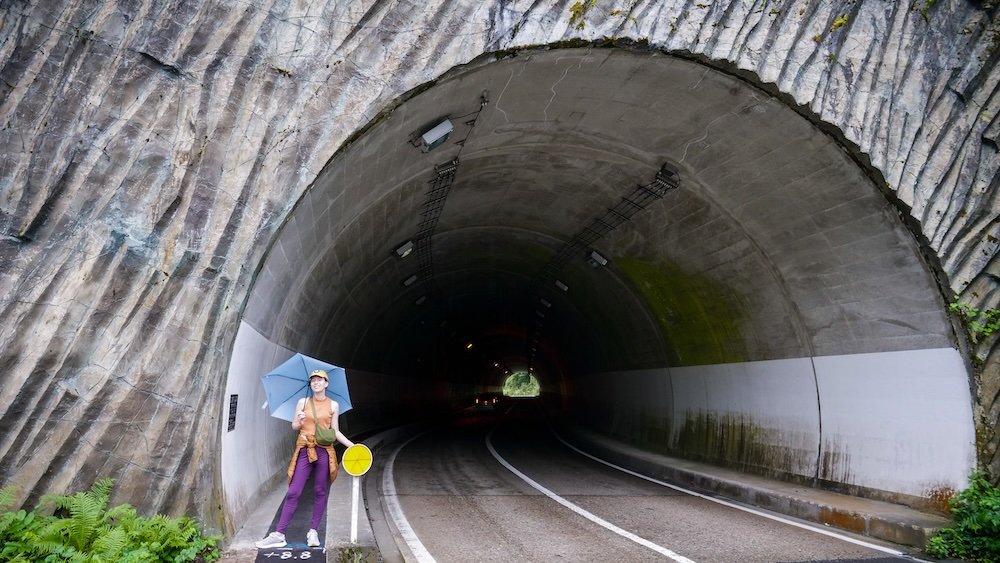
Planning Your Trip: Best Time, Weather & Crowds
The Tunnel of Light changes character with the seasons. Thus, timing your visit is half the magic. If you can, aim for the first hour after opening or the last entry window for a calmer experience.
- Weekdays are noticeably quieter than weekends and national holidays.
- Autumn foliage and Golden Week draw the heaviest crowds—pad your schedule.
- Cloudy days are excellent for even, reflection-friendly light (less glare).
- Summer can be humid inside the tunnel; dress in breathable layers.
- In winter, confirm transport and carry traction-friendly footwear.
Timing Cheat Sheet
| Season | What You’ll See | Crowds | Comfort | Photo Note |
|---|---|---|---|---|
| Spring (Apr–May) | Fresh greens, snow caps in distance | Low–Medium | Mild | Soft light, subtle contrasts |
| Summer (Jun–Aug) | Deep greens, high contrast | Medium–High | Warm/humid | Polarizer helps manage glare |
| Autumn (Oct–Nov) | Peak koyo foliage | High (esp. weekends) | Cool/crisp | Golden hour = painterly tones |
| Winter (Dec–Mar) | Minimalist rock + ice | Low–Medium | Cold | Misty breath can add atmosphere |
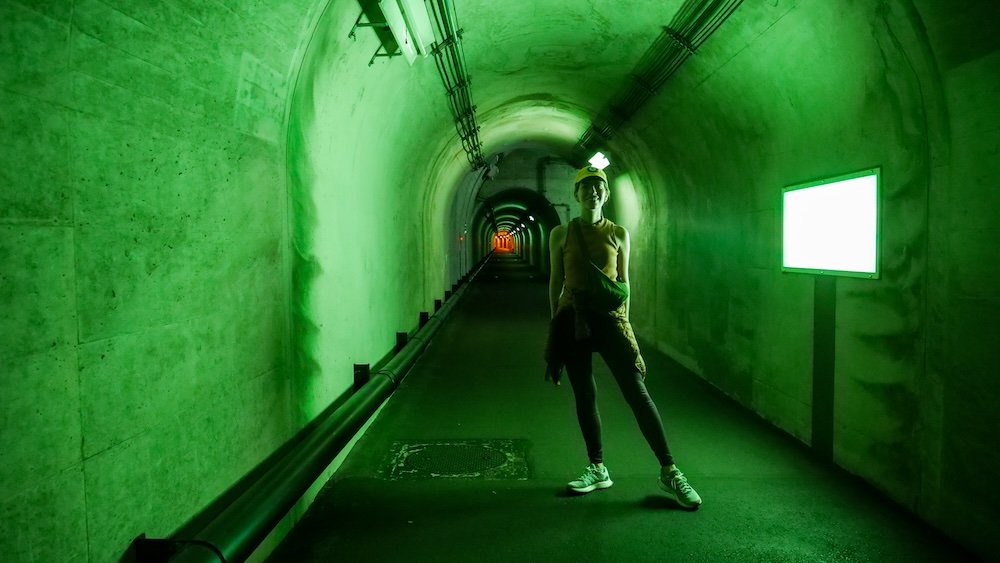
Tickets, Hours & On-the-Ground Logistics
You’ll purchase admission a few meters inside the tunnel at the staffed booth on the right. Bring cash as rural attractions sometimes have card hiccups. Hours vary by season. Expect a leisurely 60–90 minutes to enjoy all platforms plus a rest at Periscope’s foot bath afterward. If you’re arriving by bus, snap a photo of the return timetable at the stop—service can be infrequent, especially mid-day and in winter. Missed the bus? Taxis can be booked from the tunnel’s entrance office or via the station’s taxi stand.
- Carry small bills/coins for admission and snacks at Periscope.
- Keep your ticket handy—staff may re-scan at platforms on busy days.
- Last bus returns may be earlier in winter; set an alarm 10 minutes prior.
- Parking is free, with overflow lots signposted during peak times.
- Allow extra time for the 20-minute walk from the bus stop (gentle incline).
Practicalities
| Topic | Typical Details | Insider Tip |
|---|---|---|
| Admission | ~¥1,000 adult (subject to change) | Kids discounts sometimes apply—ask at the booth |
| Hours | Daylight; seasonal variation | Last entry ~30–45 min before closing |
| Payment | Cash preferred | ATMs available at Echigo-Yuzawa Station |
| Time Needed | 60–90 minutes + foot bath | Add 20 min walk each way from bus stop |
| Transport | Bus, taxi, or self-drive | Photograph the return timetable at arrival |
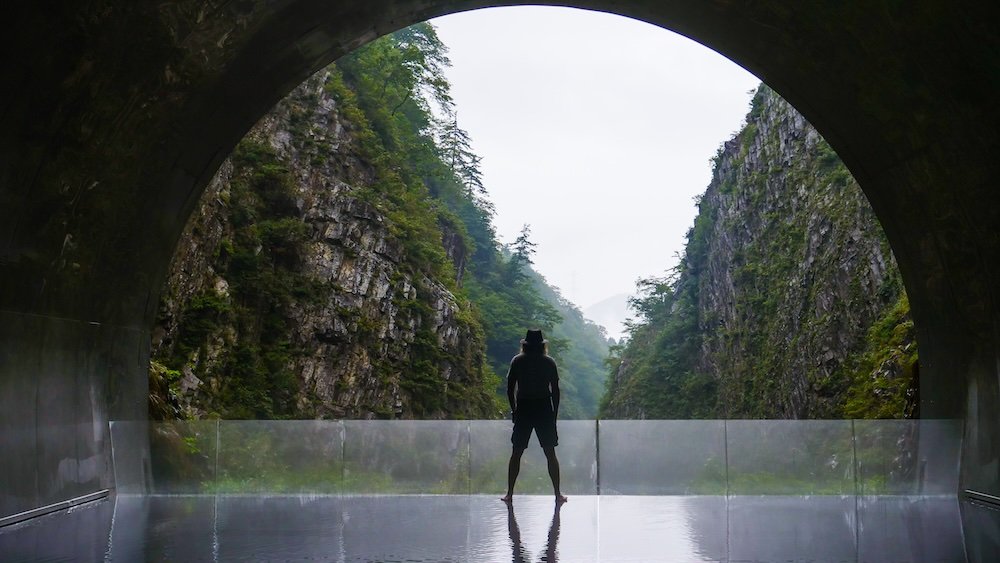
Photography & Reflection Pool Tips (Without Being “That Person”)
The Light Cave’s mirror-still pool is the star. But every platform rewards a patient eye. And remember: it’s an art space—take your shot, then give others the same clean composition.
- Polarizing filters tame tunnel glare and deepen greens outside.
- Clean your lens—humidity and mist can soften contrast fast.
- Shoot vertical for that “infinite tunnel” feel; horizontal for context.
- Ask before placing tripods; staff may restrict them when crowded.
- Move back a couple of meters for a full-body silhouette in the pool.
Shot List
| Spot | Focal Length | Composition Cue | Best Window |
|---|---|---|---|
| Light Cave (Panorama) | 24–28 mm | Centered vanishing point + silhouette | Early/late for calmer crowds |
| Drops (Platform 3) | 28–35 mm | Mirror “droplets” + gorge fragments | Overcast = even glow |
| FLOW (Platform 2) | 24–35 mm | Swirling lines + mirrored dome | Any time; watch foot traffic |
| Passageway Colors | 26–28 mm | Human scale against colored bands | First hour = moody empty frames |
| Periscope Foot Bath | 24–35 mm | Cone skylight reflection | Post-visit rest, natural light |
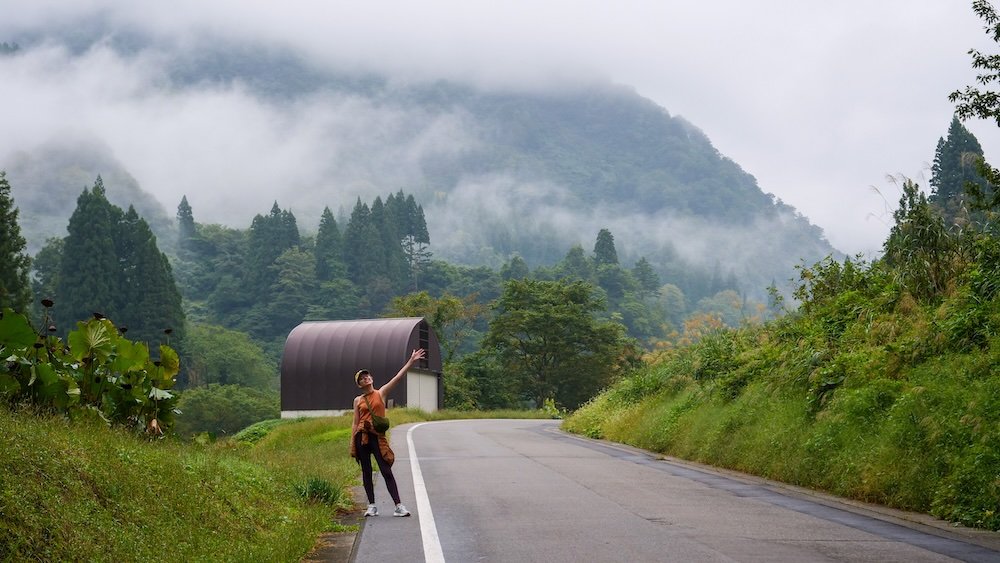
What to Wear & Pack (Tunnel Comfort = More Fun)
The tunnel is cool and slightly damp year-round. Think layers: a light shell or cardigan you can zip up for the long walk, and breathable fabrics if you’re visiting in summer. Footwear with grip is key. Finally, bring water. The tunnel itself has no vending.
- Closed-toe shoes with tread (no slick soles).
- Quick-dry layers; humidity can creep up in summer.
- Microfiber towel (pool/foot bath).
- Phone power bank for photo-heavy visits.
- Compact umbrella in shoulder seasons.
Packing List
| Item | Why You’ll Want It | Notes |
|---|---|---|
| Grippy shoes | Damp floors, slick metal edges | Trail sneakers > fashion soles |
| Light shell | Cool tunnel air | Stuffs into small bag |
| Towel | Pool & foot onsen | Hand-size is enough |
| Power bank | Photos + maps + timetables | Reception is fine; battery drains fast |
| Cash | Tickets & snacks | Small bills for speed |
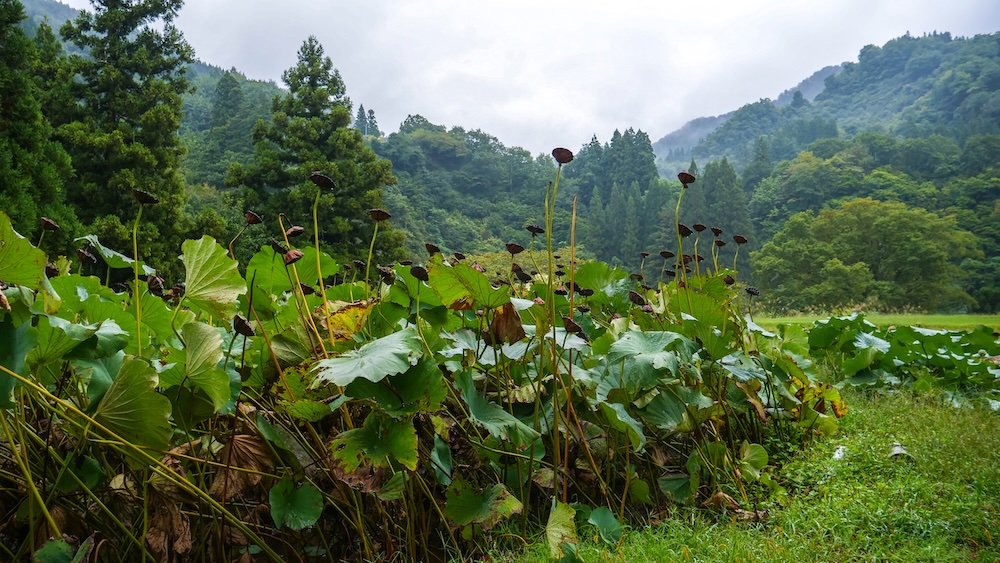
Accessibility, Families & Etiquette
The tunnel’s main passage is level and wide, making it broadly accessible for wheelchairs and strollers; however, expect occasional shallow puddles and slightly uneven patches. The platforms are step-free. There’s an accessible restroom at the tunnel’s “Invisible Bubble” stop.
- Stroller-friendly route throughout; baby carriers are great for hands-free photos.
- The mirrored restroom is one-way view—private inside, reflective outside.
- No litter bins in the tunnel—pack out any wrappers.
- Food is best saved for the Periscope shop area; water is fine in the tunnel.
- Offer to shoot a quick photo for solo travelers—spread the good tunnel karma.
Accessibility & Courtesy
| Scenario | Good to Know | Pro Tip |
|---|---|---|
| Wheelchair/stroller | Level path, occasional damp spots | Bring a small cloth to wipe wheels after |
| Restrooms | Mirrored “Invisible Bubble” on Platform 2 | Accessible stall available |
| Kids | Safe but slick near pool | Non-slip shoes make a difference |
| Noise | Sound travels in the tunnel | Record voice-overs after you exit |
| Trash | Carry-in, carry-out | Use Periscope bins post-visit |
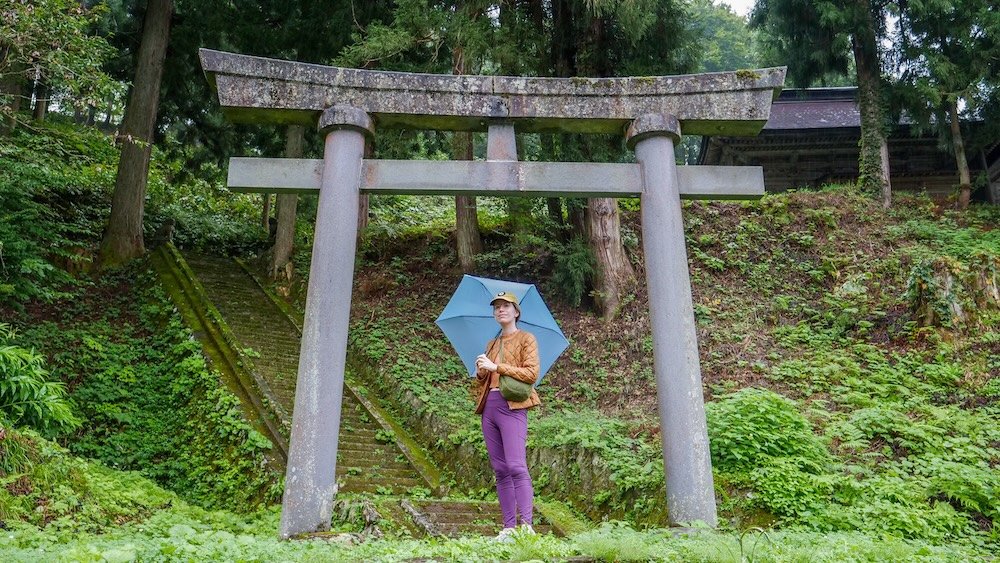
Make It a Day: Easy Add-Ons Near Kiyotsu Gorge
If you’ve come all the way to Niigata, build a mini-itinerary around the tunnel. Pair it with an onsen soak in Yuzawa (day-use baths welcome travelers). Wander small galleries and outdoor works from the Echigo-Tsumari Art Field scattered across Tokamachi and neighboring towns.
- Onsen time: Yuzawa has multiple day baths near the station.
- Art trail: Seek out a couple of permanent ETAT installations year-round.
- Rice terrace viewpoints: Rewarding short detours for sunset skies.
- Cafés & soba: Hand-cut noodles and regional sweets are easy wins.
- Local sake: Breweries and shop tastings showcase Niigata’s famous rice.
- Nearby Pairings
| Place | Travel Time (from tunnel) | Why Go | Snack Idea |
|---|---|---|---|
| Echigo-Yuzawa Onsen | ~30–40 min bus/taxi | Soak post-walk | Onsen manju (steamed buns) |
| Tokamachi town | ~30–45 min drive | Art + craft shops | Warabi mochi, iced matcha |
| Rice terraces (various) | 20–60 min drive | Golden hour landscapes | Local convenience store picnic |
| Station area cafés | On the way back | Coffee & cake wind-down | Seasonal chiffon cake |
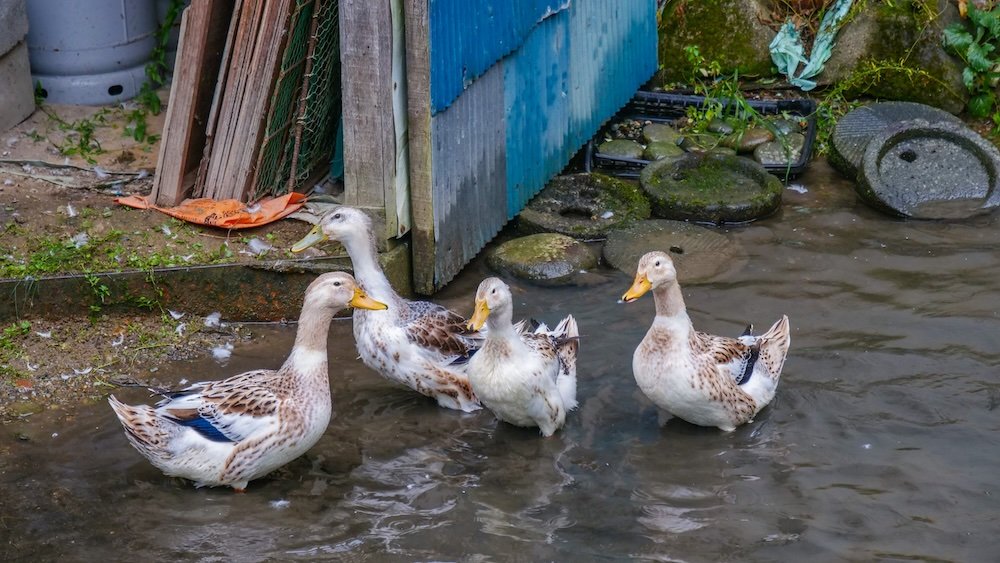
Sample Itineraries from Echigo-Yuzawa (No Car, No Stress)
Even on buses you can cover a lot without rushing. For a half-day, go tunnel-first, then sink into a bath and a bowl of soba back in Yuzawa. If you have a full day, add one or two permanent Echigo-Tsumari installations and wrap with a slow train ride and ekiben. Traveling with kids? Keep transit simple: one outbound bus, one taxi back to hit your timing sweet spot.
- Half-Day Classic: Yuzawa → bus to Kiyotsu → Tunnel (90 min) → Periscope foot bath (15 min) → bus back → onsen + late lunch.
- Full-Day Art & Nature: Early bus → Tunnel → taxi to a nearby permanent ETAT artwork → café → back to Yuzawa for sake tasting and dinner.
- Winter Window: Late morning tunnel (warmer) → taxi back (daylight) → indoor museum/café time near station.
Ready-Made Plans
| Itinerary | Start | End | Highlights | Food Stop |
|---|---|---|---|---|
| Half-Day Classic | 09:30 bus | 14:30 onsen | Tunnel + foot bath | Soba near Yuzawa Station |
| Full-Day A/N | 08:30 bus | 18:00 dinner | Tunnel + ETAT + café | Countryside café lunch |
| Winter Window | 11:00 bus | 16:00 tea | Tunnel in warmest hours | Station café + sweets |
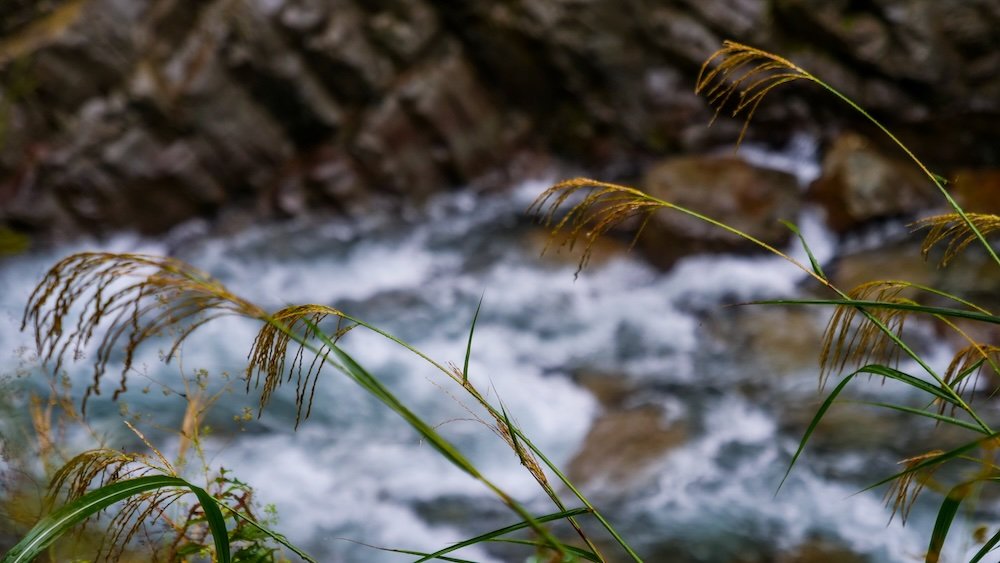
Getting There Smoothly: Bus, Taxi & Winter Driving Notes
From Echigo-Yuzawa Station, the bus to Kiyotsukyo Iriguchi is straightforward—platform signage is clear, but always confirm with the driver (show a map pin if needed). The 20-minute walk from the stop is pleasant and signposted.
- Screenshot the station timetable and your return bus times.
- Share your live location with your travel buddy; coverage is solid.
- In winter, plan daylight transport—rural roads get dark early.
- Keep the tunnel’s phone number or URL for any day-of notices.
- If you’ll miss your bus, call ahead to your hotel/ryokan for taxi help.
Transportation Tools
| Mode | Duration | Cost (approx.) | Tip |
|---|---|---|---|
| Bus (station → stop) | ~30 min | ¥ | Snap the return schedule at the stop |
| Walk (stop → tunnel) | ~20 min | Free | Follow “Kiyotsukyo” signs; gentle climb |
| Taxi (station ↔ tunnel) | 25–35 min | ¥¥¥ | Split fare if 2–4 people—often worth it |
| Self-drive | ~20 min from IC | Fuel + tolls | Winter tires essential in snow |
Kiyotsu Gorge Tunnel of Light (Niigata): 12 Essential FAQs for First-Timers (Getting There, Tickets, Best Time, Photos & Etiquette)
How do I get to the Kiyotsu Gorge Tunnel without a car?
Take the Joetsu Shinkansen to Echigo-Yuzawa Station, then the bus toward Morinomiyahara and get off at Kiyotsukyo Iriguchi. From there it’s a ~20-minute walk (gentle incline) to the entrance. If you miss the bus, grab a taxi from the station or ask staff to call one at the tunnel office.
Where do I buy tickets, and how long should I plan?
Tickets are sold a few meters inside the tunnel at the right-hand booth. Most visitors spend 60–90 minutes to enjoy all platforms plus a short soak at Periscope’s foot bath afterward.
What exactly is the “Tunnel of Light”?
It’s a 750-meter renovated tunnel turned art experience for the Echigo-Tsumari Art Triennale (2018). Along the way you’ll pass immersive installations—Expression of Color, FLOW, the mirrored Invisible Bubble (yes, a toilet!), Drops, and finish at the reflective Light Cave (Panorama Station).
When is the best time of day and season to visit?
First hour after opening or last entry window = fewer people and calmer reflections.
- Spring: soft greens, mild temps
- Summer: deep greens, humid—dress light
- Autumn: peak foliage + crowds; golden hour is glorious
- Winter: stark rock/ice scenes; check transport and wear traction shoes
Can I step into the reflection pool at the Light Cave?
Yes—barefoot or with shoes is allowed (watch posted signs). Move slowly, keep water shallow and still, and be mindful of others waiting for their shot.
Are tripods, drones, or flashes allowed?
Policies can vary by day/staffing. As a rule of thumb: no drones, flash politely (or avoid it), and tripods may be restricted during busy periods. Ask a staff member if unsure, and be ready to shoot handheld.
Any pro photography tips for mirror-clean shots?
Bring a lens cloth (humidity!), consider a polarizer to tame glare, and stand back a few meters to frame full-body silhouettes. Overcast or low-sun hours yield the most even reflections; compose quickly and rotate through so everyone gets a turn.
Is the tunnel accessible and family-friendly?
The main passage is wide, step-free, and mostly level (expect occasional damp patches). Strollers and wheelchairs can pass; the Invisible Bubble platform includes restroom facilities. Non-slip shoes for kids help near the pool.
What should I wear and bring?
Closed-toe, grippy footwear, a light layer (tunnel is cool), small towel (pool/foot bath), water, and a power bank. Rural venues can have card hiccups, so carry cash and small coins.
How does the Periscope foot bath work?
Periscope (by the entrance) has a shop at ground level and a cone-skylit foot onsen upstairs. It’s a perfect post-tunnel stop: rest, warm your feet, and enjoy a snack before heading back to the bus/parking.
Is there food, parking, and are there lockers?
Snacks and sweets are sold at Periscope; full restaurants are back in Yuzawa/Tokamachi. Parking is free with overflow lots on peak days. Lockers aren’t typical at the tunnel—pack light and keep hands free for photos.
What else should I combine with this trip?
Pair the tunnel with Echigo-Yuzawa onsen (day-use baths), a couple of permanent Echigo-Tsumari Art Field installations, rice-terrace viewpoints, or a café stop in Tokamachi. In winter, time your daylight transport and keep an eye on bus return schedules.
